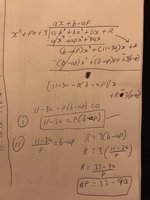You are using an out of date browser. It may not display this or other websites correctly.
You should upgrade or use an alternative browser.
You should upgrade or use an alternative browser.
Long division
- Thread starter Mickof
- Start date
Dr.Peterson
Elite Member
- Joined
- Nov 12, 2017
- Messages
- 16,084
Good.
Now, what will be the constant term in the quotient? Take the next step, including the subtraction, and show us what you get.
This is not the prettiest problem one could do, but the ideas, as tk said, are really "normal".
Now, what will be the constant term in the quotient? Take the next step, including the subtraction, and show us what you get.
This is not the prettiest problem one could do, but the ideas, as tk said, are really "normal".
Otis
Elite Member
- Joined
- Apr 22, 2015
- Messages
- 4,414
That's correct, Mickof, and you have ax as the first term in the quotient.… after subtracting … I get
(b-ap)x^2 + (11-3a)x + r …
Don’t really know the rest
So, now we're working with (b-ap)x^2 + (11-3a)x + r.
That is, how many times does x^2 go into (b-ap)x^2 ?
The answer to that question becomes the second term in the quotient. Then multiply and subtract, just as you did in the first step.
I think when you said "normal division", you were referring to longhand division of one Whole number by another. When tkhunny and Dr. Peterson talked about "normal", I think they were referring to the basic, mechanical process of multiplying and subtracting polynomials -- that is, the symbolic manipulation of algebraic expressions. We have to think abstractly, to see the correlation between dividing with actual numbers and doing it with symbolic numbers.
For example, if you have two polynomials that look like (11-3a)x and p(b-ap)x, and you need to subtract the second from the first, then you need to see two symbolic numbers 11-3a and p(b-ap) and simply write out the subtraction of those -- without being concerned what the result "looks" like. Just be careful, when writing down the symbolic expressions, to be sure that you've written exactly what you're trying to do.
(11-3a)x - p(b-ap)x = [(11-3a) - p(b-ap)]x
So, for example, the symbolic number (11-3a) - p(b-ap) may not look pretty, but it's a normal algebraic expression.
?
Last edited:
When I said normal I suppose I meant long division when I just had an x^3 and an x^2 and an x and I was dividing maybe something like x+4 into it I can do it with no problems but this question with so many variables has thrown me - back to this Q “That is, how many times does x^2 go into (b-ap)x^2 ? “ the answer b-ap ?
D
Deleted member 4993
Guest
Is this the "complete" problem or is it part of a different problem?I can do normal division but can’t get this one- thanks
Divide ax^3+bx^2+11x+r by x^2+px+3
Dr.Peterson
Elite Member
- Joined
- Nov 12, 2017
- Messages
- 16,084
Do you recognize that the stated condition implies that the remainder you get must be zero? The answer, then, will come from setting each coefficient in your remainder to zero.
What remainder do you get?
What remainder do you get?
D
Deleted member 4993
Guest
That is a horse of different color!Its part of another problem but I should be able to divide it in to help me solve it

Now the problem becomes:
(ax2 + px + 3)(x + d) = ax^3+bx^2+11x+r
we get
ad + p = b .............................equating terms containing x2
and
pd + 3 = 11 .............................equating terms containing x
and
3d = r ...................................equating constant terms
continue............
- Joined
- Apr 12, 2005
- Messages
- 11,339
This is why we try not to use ill-defined terms.When I said normal I suppose I meant long division when I just had an x^3 and an x^2 and an x and I was dividing maybe something like x+4 into it I can do it with no problems but this question with so many variables has thrown me - back to this Q “That is, how many times does x^2 go into (b-ap)x^2 ? “ the answer b-ap ?
Dr.Peterson
Elite Member
- Joined
- Nov 12, 2017
- Messages
- 16,084
Are you saying this is the remainder you got, or are you responding to Khan's different (and possibly easier) method?11-3a)x - p(b-ap)x = [(11-3a) - p(b-ap)]x
so that is the answer - and if I bring to the other side I get 11-3a= p(b-ap) ?
If you got a remainder of [(11-3a) - p(b-ap)]x, then you would set the coefficient (11-3a) - p(b-ap) equal to zero, since the remainder has to be 0. That is what leads to the answer to part i.
But there should also be a constant term in the remainder, which should yield part ii.
Otis
Elite Member
- Joined
- Apr 22, 2015
- Messages
- 4,414
Hi Mickof. Yes! So b-ap is the second term in the quotient. Now you multiply the divisor by that term and subtract (just as you did with the first term).… back to this [question:] “… how many times does x^2 go into (b-ap)x^2 ?“ the answer b-ap ?
Rich (BB code):
(b - ap) x^2 + (11 - 3a) x + r
- (b - ap) x^2 + p(b - ap) x + 3(b - ap)
----------------------------------------------------------
0 + [11 - 3a - p(b - ap)] x + r - 3(b - ap)That polynomial is the remainder (because its degree is smaller than the degree of the divisor). The division is complete.
The quotient is ax + b - ap.
You already understand why the remainder must be zero, yes? Hence, both terms in the remainder must equal zero. Set the coefficient on the x-term equal to zero, and do the same with the constant term.
11 - 3a - p(b - ap) = 0
r - 3(b - ap) = 0
A few final steps of algebra (including substitution) -- using those two equations -- give us the two equations required in the exercise.
With additional practice, dividing polynomials that have expressions for coefficients will become "normal". We view those expressions as representing single numbers, and then we apply arithmetic operations on them as if they are.… so many variables has thrown me …
By the way, there is only one variable in this exercise: x. The other symbols are parameters; they represent constants.
?
Dr.Peterson
Elite Member
- Joined
- Nov 12, 2017
- Messages
- 16,084
Do that subtraction to get the remainder; it is what Otis showed last time! Then, as he showed, each coefficient must be zero, and each of them yields one of the facts you are to prove.
But you should also look at post #11, which shows a less complicated method for solving the problem, avoiding the division entirely. There, you just expand the produce and equate coefficients.
This idea of equating coefficients is used in both methods. Perhaps you don't understand it. The idea is that if two polynomials are equal for all x, then their coefficients must be the same -- that is, they must be the same polynomial.
But you should also look at post #11, which shows a less complicated method for solving the problem, avoiding the division entirely. There, you just expand the produce and equate coefficients.
This idea of equating coefficients is used in both methods. Perhaps you don't understand it. The idea is that if two polynomials are equal for all x, then their coefficients must be the same -- that is, they must be the same polynomial.



